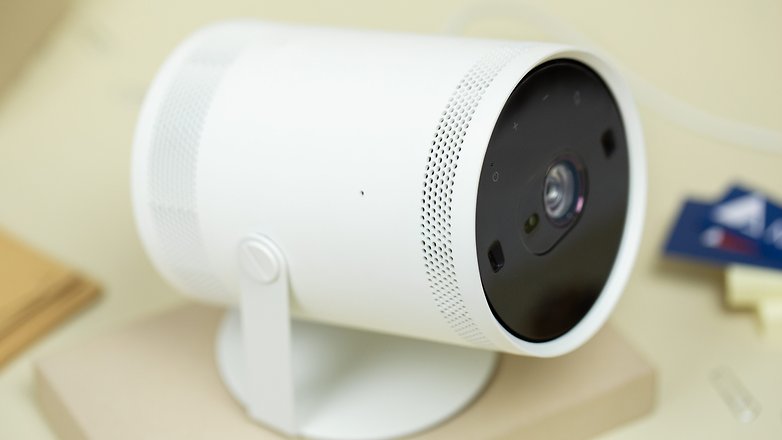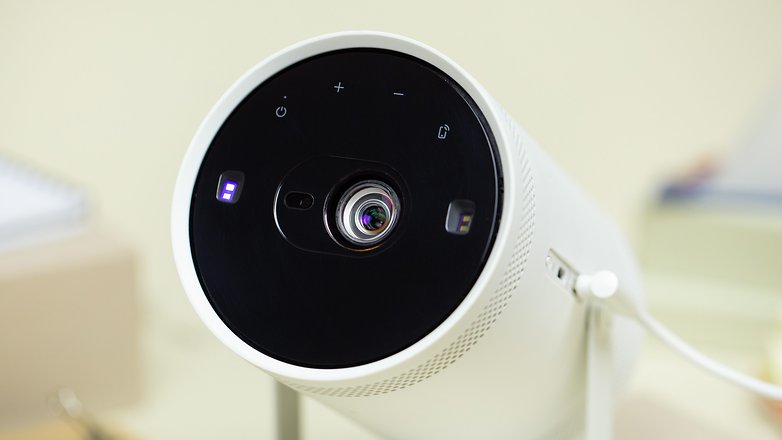Samsung Freestyle review: Portable entertainer with its quirks


With the Freestyle, Samsung tries to revolutionize the "projector" concept. While conventional models are best installed in the living room and never moved again after the initial setup, it is highly encouraged you take the Freestyle with you. This works excellently in the review, but Samsung's $899.99 gadget is not quite the finished article yet.
Good
- Easy setup process
- Numerous smart features
- Lots of entertainment options
- Great looking picture in dark rooms
- Good sound
Bad
- No built-in battery
- Excruciatingly slow TizenOS
- Transport case available as a separate purchase
- Locking is not always completely reliable
- No optical zoom
- No water and dust protection

The Samsung Freestyle in a nutshell
For the price of $500, the Samsung Freestyle would have been a super cool gadget! However, the hardware of this smart projector is simply too high a hurdle for most for less than $900, because the pre-installed TizenOS runs excruciatingly slow. Furthermore, you will have to buy a protective cover and a power bank for outdoor use.
Apart from these negative points, the Freestyle is a great concept for getting your entertainment kicks no matter where you are. It is much easier to set up than conventional mini-projectors and the integrated speakers can actually be used. The fact that the Freestyle can also accommodate a Smart TV and ambient room lighting is also really great. I would be wary about recommending anyone to purchase this, unless you find a really cool offer.
Design & Performance
The Samsung Freestyle looks different from conventional mini-projectors. This is because Samsung deviates from the traditional rectangular shape and packed the projector, speakers, and smart TV brain into a cylindrical form factor. This sits on a 180-degree hinge, making the Freestyle the most flexible projector in the world. An IP certification and a protective cover in the box would be desirable, though.

What I liked:
- Cool and very functional design.
- Exchangeable rubber cover.
- Stable stand on most surfaces.
What I disliked:
- Protective cover is optional and too expensive at $59.99.
- Far too few ports.
- Inconvenient button positions.
The design of the Samsung Freestyle is best described by pictures, because it is wonderfully unconventional. The mini-projector consists of a stand with a 180-degree hinge and a primary unit that is made up of the projector, speakers and other hardware. In front, you'll find some touch buttons and on two ports (USB-C for power and mini-HDMI) on the left side.
If you have ever used a projector, you will know that this is not enough. You will need an optional adapter to connect additional hardware like Blu-ray players or your notebook to the Samsung Freestyle. It is also a shame that the USB-C connector does not support the Thunderbolt standard, so you cannot connect laptops via USB-C.

The position of the buttons on the projector's front is also annoying during the review period. These are touch-sensitive surfaces that are difficult to see during operation as a super-bright LED lamp shines in your face. So it's best not to lose the included remote, which is similar to the Apple TV remote and does a good job overall.
While the remote is included, you'll have to buy a protective cover for outdoor use. This is quite expensive at $59.99 but it is made from really high-quality material. If you are surprised by a rain shower outside, you should quickly pack the mini-projector within this protective cover, because it does not naturally offer protection against water and dust.
Image quality and auto-lock
The Samsung Freestyle relies on LED technology and has a maximum resolution of 1080p. Compared to other mini-projectors, this is rather dark with a brightness of 550 LED lumens, but it can sharply display screen sizes anywhere from 30 to 100 inches. Samsung specified a lamp life of 20,000 hours. The operating noise of 30 decibels is similar to a loud notebook fan.
What I liked:
- Great picture despite 1,080p resolution in dark rooms.
- Many features for auto-lock.
- Not too loud, even at maximum brightness.
What I disliked:
- 550 LED lumens is too dark in broad daylight.
- No optical zoom.
- Rotation is not manually adjustable.

On paper, the Samsung Freestyle doesn't blow any projector away. After all, 550 LED lumens of brightness and a maximum resolution of 1,920 x 1,080 are average at best for a mini-projector. In the practical review, however, the projector managed to convince with a sharp display thanks to its autofocus capability and great colors. Furthermore, there are many available options to adjust the picture in the settings.
What you (mostly) don't have to worry about with the Freestyle is the image lock. For this, the manufacturer has included both an autofocus, automatic keystone correction, and a tilt function. The shadow that naturally arises with keystone corrections. After all, projectors cannot project the light around the curve, and it is also pleasingly low in dark rooms.

However, it's a pity that Samsung didn't include optical zoom. Although you can reduce the picture if the distance to the wall is too large (maximum 2.7 meters to the wall), you will lose some resolution in the process. It is also annoying that you cannot manually adjust the rotation of the picture. This causes the problem where the picture was displayed at an angle, even though the Freestyle was placed on a straight surface.
Smart functions & performance
Samsung has equipped its Freestyle with a full-fledged TizenOS operating system. You are familiar with this if you already have a Samsung smart TV in your living room. Fortunately, you can access the Samsung TV Plus service as well as apps for Netflix, Disney+, Amazon Prime Video and many more. This is where Tizen scored points with us, even if the performance is atrocious.
What I liked:
- Huge entertainment catalog of movies, series, TV programs and games.
- Seamless Samsung ecosystem (Tap View, linking with Samsung smart TVs and more) experience.
- Can also be used as an ambient room light.
- Alexa and Bixby on board.
- AirPlay compatible.
What I disliked:
- Very sluggish performance.
Samsung's mini-projector scored particularly well in its multimedia capabilities as that's exactly what it was designed for. The Freestyle makes up for the missing ports with a colorful bouquet of streaming content. The extensive app store in TizenOS offers apps for all popular media libraries and streaming services as well as numerous mobile games.

In addition, Samsung TV Plus is a free live TV provider on the Freestyle, which curiously displayed the Spongebob Squarepants series every time it booted up in the review. Apart from the Spongebob channel, there are almost 90 other channels that you can check out in the linked channel list. This degree of integration into the Samsung ecosystem is rounded off by Tap View and the ability to link to smart TVs via the home WLAN.
What is the next smart topic? Voice assistants! There are microphones in the smart mini-projector that you can deactivate via a hardware switch. Bixby or Alexa can then listen to your voice instructions. Another positive feature is how you can turn the projector into an ambient room light via the included protective cap. Samsung installed a few Ambience screensavers on the 2.5 GB of internal memory for this very purpose.
Unfortunately, Samsung did not provide additional information on the rest of its hardware. That is a pity, because then I would know which processor I would have to demonize every day from now on. This is due to the sluggish performance of the Samsung Freestyle during the review. Websites took several seconds to load in the Samsung Internet browser and there was lag from time to time. I have recorded this for you in the following video.
If I had spent $900 on the Freestyle, I would possibly send it back with such a slow operation. That would be a shame, because the entertainment options are unique for a mini-projector.
Speakers: Sufficient and expandable
The Freestyle has a 5-watt speaker that is supposed to enable 360-degree sound. Dolby Digital Plus, Adaptive Sound, Dialog Enhancement and, above all, Bluetooth is connectivity for connecting external speakers are also on board.
What I liked:
- Solid volume for watching movies without any comprehension problems.
- Connection to Bluetooth speakers possible.
What I disliked:
- 360-degree sound does not equal to surround sound.
- No audio-out port.
The integrated 5-watt speaker in the Samsung Freestyle does its job well enough. By that, I mean that you can turn up movies and series loud enough to understand the dialog without having to listen closely. At the same time, the speakers drown out the Freestyle's fan noise without any problems.

The 360-degree sound that Samsung advertises, however, does not describe a 3D surround sound as I erroneously assumed. Instead, the sound is sent 360 degrees from all sides of the speaker. This feature is especially useful when you point the projector upwards orthogonally to the floor and project the image onto the ceiling.
While I was pleased with the menu's easy ability to connect Bluetooth speakers and even peripherals like a mouse and keyboard, I personally miss a wired audio out port. Thus, I cannot connect my analog stereo system with a 3.5 mm jack adapter. This is annoying, but cables are obviously a sign of being too flexible for Samsung!
Battery...or not
Samsung's Freestyle does not have a built-in battery. According to Samsung, you have to buy a "Battery Base" for almost $180 or connect a power bank instead. At this point, I would like to emphasize once again that the Freestyle was designed for flexible use everywhere.
What I liked:
- Moderate power consumption.
- Works with powerbanks.
What I disliked:
- No built-in battery.
- Expensive battery base.
Selling a portable mini-projector without a built-in battery is quite a brave move. Especially since popular models like the Nebula Capsule come with long-lasting internal batteries for a much lower price. Instead, Samsung suggests that you invest another $180 for a battery base that clamps onto the bottom of the projector.

Alternatively, you can also power the Freestyle with an external powerbank. However, this has to support an output power of 65 watts, which is what the Freestyle requires in order to work. The battery life is, of course, dependent on your powerbank, but the model included by Samsung for review purposes theoretically manages almost eight hours of continuous playback with 23,800 mAh. You will pay just under $35 on Amazon for the model used in the review.
Final verdict
In conclusion, the Samsung Freestyle is somewhere between "ingenious" and "way too expensive". Because there are models from Anker, for instance, that also offer an integrated operating system and are even much more flexible thanks to built-in batteries at much lower prices. Samsung's model also has the advantage that you can position it more flexibly thanks to the 180-degree hinge and auto-lock functions.

Beyond that, the Freestyle scores with a huge range of entertainment options. Unfortunately, the hardware is so weak that the way to the right movie and series is a very, very tedious process. However, once the content is up and running, the picture and sound quality are very good in dark rooms, but the 550 LED lumens are simply too low in broad daylight.
If Samsung hadn't provided us with the Freestyle on loan, I would have been upset about the expensive accessories when I bought it. After all, paying a total of almost $230 for a case and an additional battery is nothing to sneeze at. Such a thing should be included with the portable projector itself. Out of spite, I would rather wrap the projector in an Apple polishing cloth for protection, because this seems exceptionally cheap in comparison at only $20. What happened to you, Samsung?




















